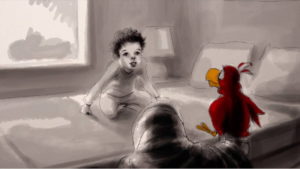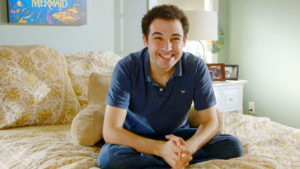 Review: Limited Theatrical Run
Review: Limited Theatrical Run
Life, Animated | Roger Ross Williams | USA | 2016 | 91 minutes
Limited Run at Sundance Cinemas starts Friday, October 26»
James Kreul suggests that reviewing Life, Animated presents a common dilemma: How to discuss an inspiring true-life story told in an uninspired documentary.
Owen Suskind “disappeared” at the age of three. His father “found” him again at the age of six.
Pulitzer Prize-winning journalist Ron Suskind shared a life changing moment with his young autistic son, Owen, in the 1990s. Suskind discovered that he could communicate with Owen, whose language skills began to deteriorate when he was 3, using Disney characters. Regardless of how you learn about that moment, whether it is in Suskind’s own work, or in interviews, or in the new documentary, Life, Animated, you can’t help but be moved by the impact such an accidental discovery has had on the lives of everyone in the Suskind family.
It’s such a beautiful, profound, and significant moment that I hesitate to suggest that Life, Animated is not a particularly distinguished documentary.
The topic of autism is shrouded in such mystery and misunderstanding—ranging from medical debates to classroom bullying—that any description and rational discussion about the lives led by those with autism should be appreciated. Life, Animated is both intelligent and insightful, and Owen Suskind, now in his twenties, is an admirable and articulate subject. Many people would benefit from seeing the film, especially those who need a relatable introduction to the topic.
But this is a review of the film, not an evaluation of Owen.
 Filmmaker Roger Ross Williams tries a bit too hard to provide Owen’s story with a conventional narrative arc, despite the fact that one lesson learned from watching the film is that autism is an ongoing struggle without any neat resolutions. Even Suskind’s discovery, using a puppet of Iago from Aladdin to talk to an uncommunicative Owen, is part of a series of ebbs and flows in Owen’s struggle, rather than a plot point that leads to a dramatic climax. Surprisingly, the Disney story is revealed within the first thirty minutes of the film, as if it were a first act in a narrative film. The second and third acts deal with adult Owen’s recent obstacles on the path to adulthood and independence.
Filmmaker Roger Ross Williams tries a bit too hard to provide Owen’s story with a conventional narrative arc, despite the fact that one lesson learned from watching the film is that autism is an ongoing struggle without any neat resolutions. Even Suskind’s discovery, using a puppet of Iago from Aladdin to talk to an uncommunicative Owen, is part of a series of ebbs and flows in Owen’s struggle, rather than a plot point that leads to a dramatic climax. Surprisingly, the Disney story is revealed within the first thirty minutes of the film, as if it were a first act in a narrative film. The second and third acts deal with adult Owen’s recent obstacles on the path to adulthood and independence.
While I have nothing against staging for the camera as a documentary technique as such, too many sequences in Life, Animated are staged to achieve a particular emotional effect that fits within the constructed story arc. In particular I’m thinking of shots of Owen looking directly at the camera and reacting as if he were watching a Disney film. But other moments in the film are similarly forced, such as the “surprise” appearance of Gilbert Gottfried (the voice of Iago in Aladdin), at Owen’s Disney discussion group. People with autism have trouble distinguishing the signal from the noise, but these sequences seem to pre-package the clear signal rather than showing us what it is like living with the noise.
I also have nothing against the use of animation in documentary, especially since films like Jessica Yu’s In the Realms of the Unreal, about outsider artist Henry Darger, or Kurt Cobain: Montage of Heck have used animation to explore the creative lives of their subjects. In Life, Animated, the animation is often a bit contrived, and perhaps too Disney-esque for its own good. In Realms, the animation helps us explore a very complex fictional world that Darger created in his writing and his artwork. In Life, Animated, the animation imposes some complex themes and ideas on top of Owen’s relatively simple fan art. At other times, the animation feels like filler, or b-roll.
As interview subjects, all the Suskind family members are very generous and open. But Ron, having worked through the material through his 2014 article and book, seems to be telling a story learned by rote, rather than allowing for much spontaneity in his early interviews. Ron is a presence, rather than a significant voice, in later sequences in the film. A far more interesting but underutilized interview subject is Owen’s older brother, Walter, who clearly hasn’t worked through all of his emotions about both the past and the future. One of the most memorable sequences features Walt on his birthday, as he contemplates the role he knows he will play in Owen’s life when their parents are gone. This doesn’t fit neatly into Owen’s story arc, so Walt’s perspective is woefully underdeveloped.
One can’t fault a subject for lacking dramatic material in his or her life, but one can fault a filmmaker for structuring a film as if the dramatic material were there. The last two-thirds of Life, Animated focuses on a series of milestones for Owen, rather than engaging dramatic conflicts. Even when there are conflicts, as is the case with Owen’s relationship with his girlfriend, the film simplifies their resolutions. We respect Owen’s struggles, but stretches of the film are simply not interesting.
An alternative to an imposed dramatic arc would be to allow Owen’s life to be as messy and confusing as it is (as all of our lives are). A model for this, not without problems of its own, would be films like Jennifer Venditti’s Billy the Kid (2007). Billy’s life is messy and confusing, and we don’t always like him. There were moments when I wanted Williams to allow us to not like Owen, because certainly that is part of the story.
Owen Suskind’s story is a very inspiring one. You feel better off having met him. The structure and execution of Life, Animated are not as interesting as Owen’s story. You might be better off meeting him through other media.